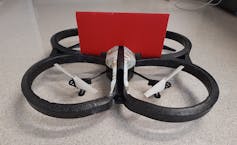drone city

The following story is based on technology developed by my research group at the University of the Basque Country / Euskal Herriko Unibertsitatea in 2024, which solves one of the biggest problems with drones taking over the city: they don’t collide.
There are only 20 years left before a fleet of safe drones appears in the skies of the most developed city. We called this city Neo-Tokyo. Nothing you read below is impossible.
red cards
In 2054, the sky above Neo-Tokyo was pulsating with life. Thousands of drones flew through the air in an intricate and perfectly coordinated dance. From his office atop the city’s control tower, engineer Akira Tanaka looked on with pride at the spectacle he had helped create.
Zeta-7, a modern postal drone, glided in the air current. Its design contained a bright red plate, a relic of the revolutionary anti-collision technology developed decades ago by Akira and his team. This plate contained all identification details of each device, both technical and commercial, and was mandatory for commercial drones.
“ARIA, show me the view from Zeta 7’s camera,” Akira ordered his virtual assistant.
The holographic display came to life, displaying a low-resolution image from the drone’s front camera. Despite its apparent simplicity, this camera became a reference point for the aerial choreography of Neo-Tokyo.
Avoid an imminent collision
Suddenly, alarms started blaring in the city. A huge cargo drone lost control and fell towards the center. Dozens of smaller drones scattered, like a school of fish facing a predator.
Suddenly, a pizza drone appeared in Zeta-7’s field of view, deviating slightly from its route. The two artificial intelligence (AI) systems had to calculate the evasive trajectory in hundredths to avoid each other and avoid a collision.
Zeta-7’s AI, a direct descendant of those primitive computer vision algorithms, went to work. The camera at full speed began to track the red color characteristic of the identification marks of multicopters.
The system quickly estimated the percentage of the image occupied by red. Based on the size of the red area, Zeta-7 estimated the distance to the other drone and began an evasive maneuver to successfully evade the Pizza Drone, which was likely off course.
“Listen, Aria,” Akira said enthusiastically. “Each drone makes a decision on its own, without communicating with each other, just based on what it sees. “Both devices look for the proximity of red and avoid each other.”
Reflections and shadows
Turning gracefully, Zeta 7 avoided the collision by turning in the opposite direction of where he had seen the greatest concentration of red. The pizza drone, an old Gamma 4 model, did the same thing, creating some beautiful aerial choreography.
“It is amazing how something as simple as the color and area of a red license plate in a camera prevents thousands of accidents,” ARIA commented.

Akira nodded, remembering the initial difficulties. “At first we had problems with reflections and shadows. But by adjusting the color detection thresholds and the minimum size of the red area, we have an incredibly reliable system.”
Meanwhile, the city alarm continued to blare. The cargo drone was still losing control and falling. The smaller drones, forced to move out of the way before what was approaching, caused their color plates to glow brightly in a technological rainbow.
Zeta 7 activated its emergency protocols, an advanced version of the RCA (mutual collision avoidance) algorithm that revolutionized urban air traffic. Its AI connected to the air traffic network and collaborated with other drones to create a flight pattern that would allow rescue vehicles to reach the disabled drone.
“ARIA, zoom in to Sector 7,” Akira ordered in a tense but controlled voice.
On the screen, hundreds of drones performed a perfect choreography, spreading out like the waters of the Red Sea. Their color-detecting and distance-sensing movements were a holdover from those early experiments with the popular older AR Drones 2.0 robots Akira’s team had been working with.
The emergency drones passed through the newly formed corridor and reached the cargo drone just in time to stabilize it. Their advanced vision systems, direct descendants of low-resolution front-facing cameras, worked perfectly.
As the crisis subsided, Akira leaned back in his chair and breathed a sigh of relief. “You know, ARIA? Many people thought it was crazy to use low-resolution cameras and simple color maps. They said we need better sensors, drone-to-drone communications, centralized traffic control systems…
“But you have shown that sometimes the simplest solution is the most effective,” the BCC concluded.
“Exactly,” Akira smiled. “Now look at the result.”
Happy ending
The sky over Neo-Tokyo has returned to its usual chaotic order: thousands of drones dance their aerial ballet, deliver packages, save lives and keep the pulse of the city of the future. Every turn and flight of the drones was an echo of those first tentative steps in a distant laboratory, a technological symphony born from a simple but revolutionary idea.
“A true genius,” Akira concluded, his eyes gleaming in the light from the drone, “finds elegant solutions to complex problems. And sometimes those decisions are right in front of our eyes—in this case, in front of our drone cameras.”
